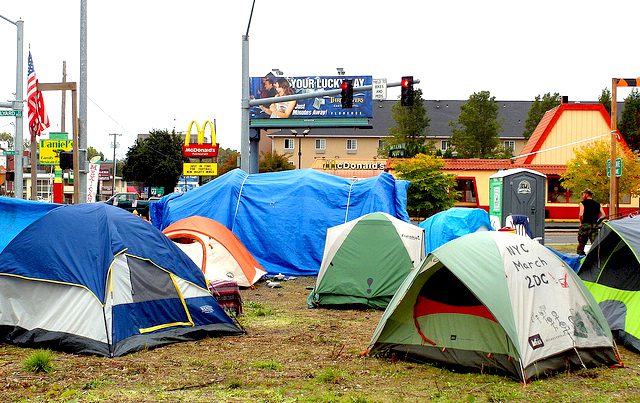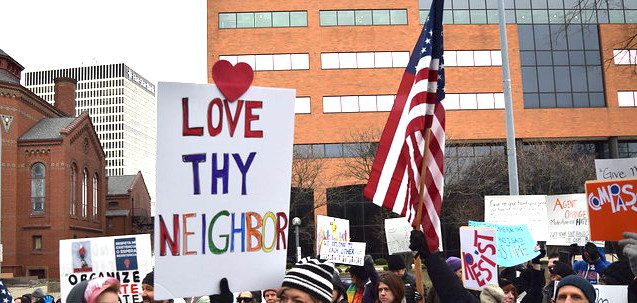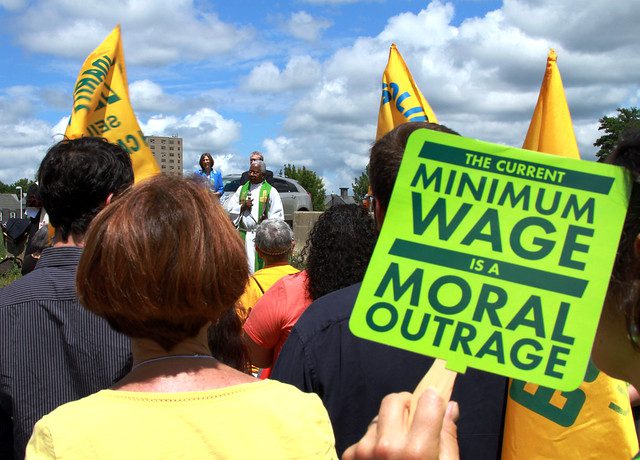
Photo credit: Wolfram Burner, via flickr, CC BY-NC 2.0.
“Over the 10 years from 2006 to 2016, changes in inclusion track more closely with changes in growth and prosperity than changes in growth or prosperity track with each other.” —From the report, Economic inclusion may be the key to lasting growth and prosperity, Brookings Institution’s Metropolitan Policy Program. (Their research supports things we’ve been saying forever, though given that infinite growth is impossible and undesirable, we’d prefer to see it framed as “inclusion, rather than growth, is the key to prosperity.”)
The writing has been on the wall for some time now that HUD under the Trump administration will be shaped into something quite different from what we’ve come to know. But somehow, as we prepare to observe the 50th anniversary of the passing of the Fair Housing Act this year, this knowledge is no more consoling. Though HUD secretary Ben Carson has said claims that the agency is moving away from enforcing fair housing laws were untrue, his stated plan to strike the words “inclusive” and “free from discrimination” from HUD’s (already brief) mission statement doesn’t seem coincidental.
In case there was any doubt that OMB Director Mulvaney was sent to the Consumer Financial Protection Bureau to destroy it, he has now officially asked Congress to take away his own agency’s independence. It is because of the context of moves like this that advocates are eyeing a report out of Treasury proposing CRA modernization, that doesn’t look nearly as bad as was feared—so far. But the devil will be in the details—when regulators actually get down to detailed rule making.
Affordable set-asides are not just for housing. Facing losses of both practical retail and culturally relevant businesses, various cities, including New York, Boulder, and Portland, are testing out the idea of reserving some commercial spaces at below-market rent for locally owned businesses. Among the interesting challenges, of course, will be defining local.
Californians may not be sure about what they want to do about their growing homelessness crisis, but its clear they don’t want the homeless living near them. In late March, a plan to create temporary shelter sites in three Orange County cities was vehemently opposed by residents and the plan was scrapped. As cities throughout the region enforce anti-camping laws and clear informal settlement sites, local officials have struggled to figure out what to do as hundreds of people disperse throughout the city. But just this week at a hearing on the matter, a federal judge said that if the cities could not come to a decision, he would not be able to enforce local anti-camping laws and they will be back where they started.
Stop mixing up social enterprise and social change—that’s the message of a highly discussed article in the Stanford Social Innovation Review, whose authors are clearly more than a little tired of the praise being heaped on social enterprise. A business-oriented model ignores issues of power, elevates the individual entrepreneur over collective action, and participates in minimizing the role of governance, they argue. While they may be fine business models, diverting social change resources and attention to social enterprise even undermines democracy: “Constructing the disadvantaged as clients or customers, rather than citizens, undermines development of an active, engaged citizenry that can use its voice to participate in public institutions and democratic processes that reflect its will and needs.” In other words, all the impact investing in the world can’t replace organizing.
Late last month, New York City Council voted to approve rezoning of a 95-block area in the Bronx that will encompass several neighborhoods. The final plan includes a promise to build two new school buildings and parks, as well as a larger amount of deeply affordable housing units, according to area council members. This rezoning is the fourth of 15 the mayor has planned, and housing advocates have complained that his stated efforts to increase affordable units in the city aren’t working, and are instead fueling displacement and a growing homelessness situation.
The National Fair Housing Alliance (NFHA) is not messing around. NFHA and three of its member organizations have filed a lawsuit against Facebook for allegedly violating fair housing laws with its advertising platform. “After being warned repeatedly about its discriminatory advertising practices, Facebook continues to use [user] data to deny people access to rental housing and real estate sales ads because of their sex and family status,” according to a release.
Take enough time to start counteracting oppressive systems, and take a chance on non-traditional leaders. These are some of the lessons NYC’s Association for Neighborhood and Housing Development suggests for training programs that are trying to diversify the fields of community organizing and community development, drawn from 10 years of experience with their leadership programs.
That community land trusts were a bulwark against gentrification has long been taken as an article of faith (or of logic). Pulling some housing units off the speculative market would have to mitigate some of the effects of a soaring market. Now some researchers have tried to put numbers to that proposition, comparing gentrifying and non-gentrifying census tracts, with or without CLTs. They found evidence that CLTs maintain racial and income diversity, reduce displacement, and keep housing costs down.
It’s no secret that gentrification is accelerating in cities across the country, displacing scores of longtime residents. And there’s no doubt that folks who are forced out of their homes face high levels of stress, which over time can lead to hospitalization for health issues like high blood pressure and heart disease. But does that mean gentrification is hazardous to your health? Yes, it does, according to this study that showed hospitalization rates for mental illness are twice as high in displaced people versus those who remain in their neighborhood. (Delve more into the intersection of health and housing with our coverage here.) And while we’re talking about health, we read this study that shows the health benefits of rental housing assistance programs like Section 8 vouchers.
What do you think about teachers living at school? It probably sounds like a bad idea at first, but it might actually be helpful. It’s difficult for school faculty in Miami-Dade County to afford the area’s high housing prices, so school and housing officials have come up with a proposal: build a new middle school with a floor dedicated to residential units. “The concept would add Miami to a scattering of cities across the country where schools are using their own real estate to provide more affordable housing to their workforces.” We’ll be keeping our eyes on this one.
A page dedicated to breast cancer and other reproductive health information—including information that was especially important to low-income individuals and people of color—was removed from the Department of Health and Human Service’s website. The pages were “rarely used” and “not mobile friendly,” according to an official. Sure. Keep telling yourself that. No word on whether those pages will be made “mobile friendly.” We won’t hold our breath.
What’s one way to help stem off the affordability crisis? How about taxing the owners of vacant properties? Vancouver has passed a law where owners of vacant properties are subject to a 1 percent tax on the property’s assessed value. Some U.S. cities have tried to pass a similar tax in the past, but the proposals went nowhere. However, if this works out well for Vancouver, it could be the example that leads the way for places like New York City. In March, the city announced a large increase in the number of vacant units that are unavailable for sale or rent, from 182,600 in 2014 up to 248,000 in 2017.
A New York judge has awarded a group of graffiti artists over $6 million in compensation for their work being painted over without consent or warning, and it may set a precedent for the legitimization of street art. It may also encourage municipalities to create formal policies that protect community art projects, like murals, when developers want to demolish or make changes to a property.
The value of art in communities doesn’t need to proven to us, but this tool from the Arts and Cultural Production Satellite Account (produced in conjunction with the NEA) allows you to view data on the economic value of arts and culture production by state.
This story from San Francisco’s public radio station KALW about lead poisoning in the Bay Area will break your heart and enrage you at once. Because of the area’s housing shortage, many families are faced with the difficult choice of living in affordable but substandard housing, or moving to areas with more affordable rents, but far away from work opportunities and transportation. Quite often these families are immigrants, and victims of something called predatory habitability, who may not even know they are being poisoned until the symptoms are severe. The reporting touches on not only the largely unseen ripple effects of the housing crisis, but cultural sensitivity, as well.





Comments